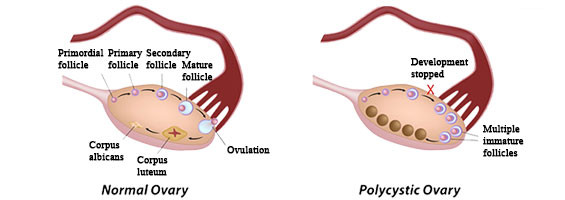Polycystic Ovary Disease is a very common problem nowadays. Every second girl is suffering from PCOS, mainly because of the kind of lifestyle and eating habits that we dwell in us. But there isn’t much to be scared about, if you built good eating habits and exercise regularly.
What Is PCOS?
Polycystic ovarian syndrome, or PCOS, is a condition in which a woman’s levels of the sex hormones estrogen and progesterone are out of balance. This leads to the growth of ovarian cysts (benign masses on the ovaries)
What are the symptoms of PCOD/PCOS?
Symptoms of PCOS typically start soon after a woman begins to menstruate. The type and severity of symptoms varies from person to person. The most common characteristic of PCOS is irregular menstrual periods.
Because PCOS is marked by a decrease in female sex hormones, this condition may cause women to develop certain male characteristics, such as:
excess hair on the face, chest, stomach, thumbs, or toes
decrease in breast size
deeper voice
thin hair
Other symptoms include:
acne
weight gain
pelvic pain
anxiety or depression
infertility
How can you treat PCOS
Regular exercise, a healthy diet, weight control, and not smoking are all important parts of treatment for polycystic ovary syndrome (PCOS). You may also take medicine to balance your hormones.
There is no cure for PCOS, but controlling it lowers your risks of infertility, miscarriages, diabetes, heart disease, and uterine cancer.
Eating habits
Instead of:
Sweetened juice, canned fruit in heavy syrup, or sweetened applesauce
Starchy vegetables such as potatoes, corn, and peas
Refined grains made with white flour such as white bread and pasta, bagels, or white rice
Sugared cereals, and other sweetened grains such as cereal bars (Nutrigrain Bars®), breakfast pastries, and donuts
Sugary drinks such as soda or juice
Sugary foods such as cookies, cakes, and candy
Snacks such as potato chips
Choose:
Fresh fruits or frozen/canned fruit without added sugar, or unsweetened applesauce
Non–starchy fresh vegetables or frozen/canned vegetables such as broccoli, spinach, and carrots
Whole grains such as whole wheat pasta, brown rice, and whole wheat bread
High fiber cereals. (Look for cereals that have at least 5 grams of fiber per serving or sprinkle ½ cup of bran cereal or unprocessed bran on a low–fiber cereal to increase the fiber)
Water or sparkling water, flavored with fruit if desired, unsweetened ice tea
High fiber baked goods made from whole wheat flour and oats
Crackers and snacks with fiber such as popcorn


Share Your Views